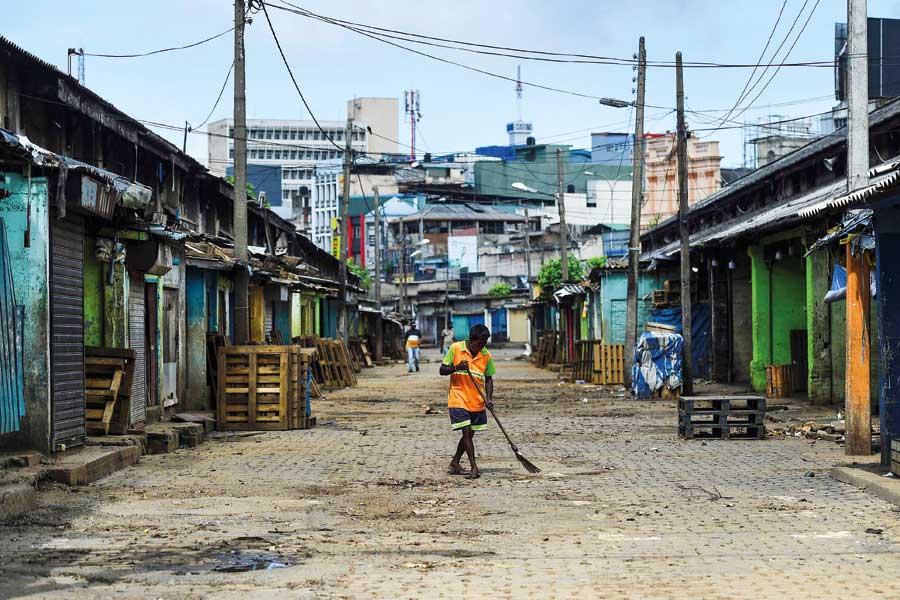28 Oct 2020 - {{hitsCtrl.values.hits}}
- Most official data are produced with lag, making timely assessments of the economic impact of coronavirus difficult
- Local, national, and international warning systems for pandemics are woefully underdeveloped
- It is too late to develop a cross-border, standardized early warning system for the first wave of COVID-19
- There is still significant uncertainty over the pace and path of the recovery
- Current communication messages in the COVID-19 pandemic tend to focus more on individual risks than community risks
- Concerned about the extra pressures being put on women’s careers during the pandemic

A municipal worker sweeps at a deserted wholesale vegetable centre in Colombo (AFP)
It is indisputable that Covid-19 is a tragedy, claiming thousands of lives and crippling economies and  livelihoods worldwide. But in Sri Lanka, where the death toll and number of cases have been relatively and significantly low, does Covid-19 qualify as a disaster? We ask Prof. Dilanthi Amaratunga, Professor of Disaster Risk Reduction and Management at the University of Huddersfield, UK, and the Head of its Global Disaster Resilience Centre.
livelihoods worldwide. But in Sri Lanka, where the death toll and number of cases have been relatively and significantly low, does Covid-19 qualify as a disaster? We ask Prof. Dilanthi Amaratunga, Professor of Disaster Risk Reduction and Management at the University of Huddersfield, UK, and the Head of its Global Disaster Resilience Centre.
 Q Why is Covid-19 considered a disaster?
Q Why is Covid-19 considered a disaster?
Coronavirus pandemic is a disaster for the entire world, more specifically a pandemic to fall into a category of biological hazards. The COVID-19 pandemic conforms to key baseline conclusions which have emerged from disaster anthropology over past decades. The anthropology of disasters has for a long time worked on similar situations, even if the scale of this pandemic is unprecedented. Although anthropology cannot “make sense” of what is occurring, it allows us to examine how humans deal with and give meaning to what they are going through. The pandemic was not the only disaster. Without disputing the need for the lock-downs seen around the world, this approach’s consequences represent further layers of the COVID-19 disaster.
Q What national level consequences do you see emerging as a result of Covid-19?
COVID-19 has governments at all levels operating in a context of radical uncertainty, and faced with difficult trade-offs given the health, economic and social challenges it raises. In the UK, as global coronavirus (COVID-19) cases rose, social distancing measures were imposed, forcing the closure of shops, businesses and schools from the end of March until the beginning of July.
The global economic contractions resulting from the COVID-19 pandemic have far exceeded those of the Great Recession that ended in 2009 and have occurred at a much faster rate, hitting all sectors and many of the world’s largest employers. The World Health Organization (WHO) published a first indicative survey on the impact of COVID-19 on health systems based on 105 countries illustrate that almost every country (90%) experienced disruption to its health services, with low- and middle-income countries reporting the greatest difficulties.
There is still significant uncertainty over the pace and path of the recovery, especially in light of the growing number of cases which have led to another round of limited national restrictions, as well as the behaviour of the virus with the changing of the weather.
Q What is the socio-economic impact of this pandemic like?
The COVID-19 pandemic is far more than a health crisis: It is affecting societies and economies at their core. Across the globe, COVID-19 is threatening cities and communities, endangering not only public health, but also the economy and the fabric of society.
The coronavirus outbreak has had profound effects on the economy, and will continue to do so. COVID-19 is already having a deep, multidimensional impact and is expected to create the worst economic contraction in decades, with job losses already at an all-time high.It has impacted on household earnings, outgoings and incomes and, in turn, likely exacerbated poverty and inequalities. The socio-economic impacts of the pandemic have tended to disproportionally affect certain groups of people, including those living in areas of greater deprivation. The COVID-19 crisis is compounding the obstacles countries already faced to eradicate poverty, eliminate inequality and combat climate change. The World Bank estimates that about 100 million people will likely to fall into poverty due to the impact of the pandemic, with as many as 49 million falling into extreme poverty. Many of these “new poor” will be people living in cities and who are self-employed, mostly working in the informal sector.
Without urgent socio-economic responses, global suffering will escalate, jeopardizing lives and livelihoods for years to come. Immediate development responses in this crisis must be undertaken with an eye on the future. Development trajectories in the long-term will be affected by the choices countries make now and the support they receive.
Against this backdrop of mounting vulnerability and increasing needs, both national and local governments are confronted with severely strained financial resources. Lower exports, a decline in tourism revenues and remittances, and an acute contraction of economic activities are translating into a precipitous drop in tax revenues.
"Prof. Dilanthi Amaratunga is a world leading expert in disaster resilience with
Prof. Dilanthi Amaratunga
an international reputation. She did her undergraduate studies at University of Moratuwa in Sri Lanka and completed her doctoral studies at the University of Salford, UK in 2001. She has produced over 400 publications, refereed papers and reports, and has made over 100 keynote speeches in around 30 countries. She is a member of the European Commission and UNDRR’s European Science and Technology Advisory Group representing the UK. She is regularly invited to provide expert advice on disaster resilience by national and local governments and international agencies. She is a Fellow of the Royal Institution of Chartered Surveyors (RICS) and a Fellow of the Royal Geographical Society."
Q Is this impact measurable? If not, why?
There are multiple data and metrics used to assess a country’s performance in responding to the threat of COVID-19. The choice of metric could influence whether a country’s response is considered a relative success or failure. One measure of their success and failure has been the number of deaths; another is the hit taken to economic output as a result of the lockdown measures. But how accurate are the data? Measuring deaths is a nightmare, but is the measurement of economic output any better? The answer is no.
Most official data are produced with a lag, making timely assessments of the economic impact of coronavirus difficult. The disruption may also have made it harder to collect accurate statistics.
Of course, without the benefit of hindsight, we cannot definitively declare successes and failures. However, it matters how we define success (and failure). Has a country succeeded if it has stopped the spread of the virus leading to a very few deaths? What if this “success” has been achieved at the expense of other non-COVID-19 deaths? What, in addition to excess mortality, must we measure or model?
Q What kind of preparations do we need to face disasters like this pandemic?
COVID-19 has been a “stress test” for countries’ preparedness plans. It underlines in a vivid way why strengthening disaster risk governance is vital if we are to meet the existential threats posed by the systemic nature of disaster risk in the 21st century, including the climate emergency.
A considerable level of emphasis need to be placed in national Disaster risk reduction and management plans on taking into account biological hazards such as epidemics and pandemics in disaster mitigation efforts including performing risk and vulnerability assessments. Biological hazards need to be adequately addressed in sub-national level disaster management plans.
The current COVID-19 disaster demonstrates that risk is systemic, and crises are cascading. Disasters are rapidly producing further disaster to become more complex and deadly. There needs to be urgent action to address the dual challenge of the COVID-19 pandemic and other hazards. Countries need to take strategically calculated and measurable actions to develop multi-hazard disaster risk reduction strategies. Twin emergencies, the amalgamation of a global pandemic with another emergency, such as due to a natural hazard, was, until recently, an inconceivable scenario. Yet this is the reality currently being faced by a number of countries around the world in light of the COVID-19 crisis. Over the last months, the world has witnessed a number of devastating natural disasters, from the earthquake which struck the city of Zagreb in Croatia, and the Tropical Cyclone Harold which caused extensive damage in the Solomon Islands, Vanuatu, Fiji, and Tonga. Responding and coping measures are limited during a pandemic.
The importance of investing in risk reduction for prevention need to be emphasised and there need to be action to ensure such a devastating global crisis cannot happen again.
Q How important is public awareness?
The end receiver of warnings is the general public, and they are the recipients of any official and unofficial warnings. Communities at risk are entitled to accurate information about the risk and instructive guidance to allow them to respond appropriately and quickly. Communities are responsible for making the necessary preparations to save themselves from disaster risks, including that of COVID-19. The public must understand: how they will be warned (official and unofficial warnings); how they need to react and respond; where do they need to go and how they can minimise any confusions.
Q How important are early warnings in the event of pandemic situations?
The rapid spread of the COVID-19 disease has demonstrated that local, national, and international warning systems for pandemics are woefully underdeveloped. Having a common framework for early action to cope with complex disasters can make it easier for authorities and other stakeholders, including populations at risk, to understand the full spectrum of a disaster’s secondary and tertiary effects and thus where to focus preparedness efforts, and how best to provide more targeted warnings and response services. The ability to understand and respond effectively to warnings through appropriate behaviour and actions is central to resilient societies and communities. By avoiding physical, societal, and economic harm to the greatest extent possible, recovery from a hazard is likely to be faster, less costly, and more complete.
It is too late to develop a cross-border, standardized early warning system for the first wave of COVID-19, but it is vital that a forensic analysis on how this crisis emerged, includes an assessment of the variable successes in warning systems adopted by countries.
At first glance, Early Warning Systems developed for tsunami and flood hazards may seem inappropriate for diseases such as COVID-19. Unlike most environmental hazards that require organised evacuation away from a crisis point, epidemics and pandemics require people to stay put so as to cut off transmission routes. Rather than protect themselves by moving away from danger, people must protect others through their immobility.
Q Do cultural factors matter in situations like these?
Culture is key to the global response to community engagement. Culture is central to effective COVID-19 messaging for community engagement. Culture shapes language, which in turn shapes communication both in message delivery and reception. In response to COVID-19, for example, in some countries, cultural sensitivity to racial and ethnic minority group experiences is believed to be critical if messages for mitigation are to have broader impact.
"COVID-19 pandemic is affecting societies and economies at their core. Across the globe, it is threatening cities and communities, endangering not only public health, but also the economy and the fabric of society"
Culture is central to an effective community-engaged public health communication to reduce collective risks. Current communication messages in the COVID-19 pandemic tend to focus more on individual risks than community risks resulting from existing inequities. It is therefore really important to emphasize the importance of culture in unpacking messages that may be the same globally (physical/social distancing) yet different across cultures and communities (individualist versus collectivist).
COVID-19 mitigation efforts that focus on individual behavior such as hand-washing and physical distancing must be balanced with structural mitigation efforts such as clean water, access to housing, unemployment, and for those with jobs, ability (type of job) and tools (access to computer and internet) to work from home. These are the daily realities of racial/ethnic and economically disadvantaged populations that bear the heaviest burden of the pandemic. Yet, culture offers communication messaging that ranges from positive aspects of lived experience that should be promoted to negative practices that should be overcome within the context of communities. There is a need to frame approaches to communications and community engagement for COVID-19, which offers a road map for engaging communities in communication about COVID-19 mitigation efforts.
Q Are women forced bear increased responsibilities in times of a disaster?
“Very early on in my career, I realised I needed to study more, I needed to prove myself three times more than any man,” being a female leader in a male-dominated industry has forced her “to be stronger and rise above myself every day”. Same applies during the pandemic, and like with many others, I am concerned about the extra pressures being put on women’s careers during the pandemic - and whether this can end up pushing them back.
Coronavirus pandemic exacerbates inequalities for women. The lock-downs triggered by COVID-19 are taking a disproportionate toll on women in the labour market, as the sectors with high rates of female employment are experiencing heavier job losses while increased childcare needs during school closures exert an outsized impact on working mothers. An estimated 740 million women are employed in the informal economy. In developing nations, such work constitutes more than two-thirds of female employment. But as countries all over the world locked down, these jobs quickly disappeared. That can have catastrophic consequences.
It has been estimated that the pandemic was preventing 1·52 billion children from attending school. Some of them will never return. Schools are a safe environment for vulnerable girls in particular, and losing this protection has huge implications on health.
It has become apparent that mortality rates were higher among men than women. This remains the case but it is women who are more likely to bear the brunt of the social and economic consequences of the pandemic. My view is that COVID-19 could reverse the limited progress that has been made on gender equality and women’s rights. Across the globe, women earn less, save less, hold less secure jobs, are more likely to be employed in the informal sector. They have less access to social protections and are the majority of single-parent households. Their capacity to absorb economic shocks is therefore less than that of men.
Women and girls are likely to experience distinct challenges and risks associated with the COVID-19 pandemic, and as such the outbreak might exacerbate already existing risks of gender-based violence. Confinement is expected to increase risks of intimate partner violence for displaced women and girls, while worsened socio-economic situation will expose refugee women and girls in particular to increased risks of sexual exploitation by community members as well as humanitarian workers. In parallel, access to regular gender-based violence services is likely to become challenging for survivors.
Q In managing a disaster like Covid-19, how should the state system be equipped?
In light of the impact of COVID-19 pandemic, coupled with sudden and slow disasters, countries need to re-examine how their laws can be updated to better reflect the increasing complexity of disasters. Concurrent disasters have brought into focus the need to ensure that national disaster management offices are well-positioned to lead prevention and response efforts that cross sectoral lines. Key to this ensuing that laws and rules enable countries, and specifically national disaster management offices, to adopt a multi-hazard approach that considers climate, biological and other hazards.
"The rapid spread of the COVID-19 disease has demonstrated that local, national, and international warning systems for pandemics are woefully underdeveloped"
All counties need to develop national and local disaster risk reduction strategies that take a truly multi-hazard approach, including pandemics and epidemics, and recognize poverty as a key driver of disaster. Some countries are already taking action in response to lessons learned from the COVID-19 pandemic response with a call to review and reform national disaster management systems.
Multi-hazard approach can be a common approach for all hazards and therefore is more likely to become a trusted tool that everyone can understand and use as a basic element of their national disaster risk management system. The interconnectedness of hazards and their impacts is a strong motivator for a common approach. One of the lessons from both the COVID-19 pandemic and extreme weather events is the need to understand the vulnerability of individuals, communities and societies so as to provide reliable, targeted guidance and warnings and ensure the willingness and capacity to prepare for a reasonable worst-case scenario based on informed long-term planning. All linked stakeholders need to make good progress in this direction, including health and other sectors. Authorities and stakeholders for emergency preparedness and response related to epidemics need to be officially designated, and the roles of such stakeholders need to be clearly outlined.
Preparedness planning for biological hazards need to be mainstreamed into the activities of sub national level Disaster Management Committees and District Disaster Management Coordinating Units.
Dissemination of early warning for epidemics and pandemics need to be an integrated process with a risk grading system for epidemics and pandemics, with a methodical risk assessment framework for epidemics and epidemics with predefined risk levels, supposed by adequate resources.
09 Jan 2025 5 hours ago
09 Jan 2025 6 hours ago
09 Jan 2025 9 hours ago
09 Jan 2025 9 hours ago
09 Jan 2025 09 Jan 2025